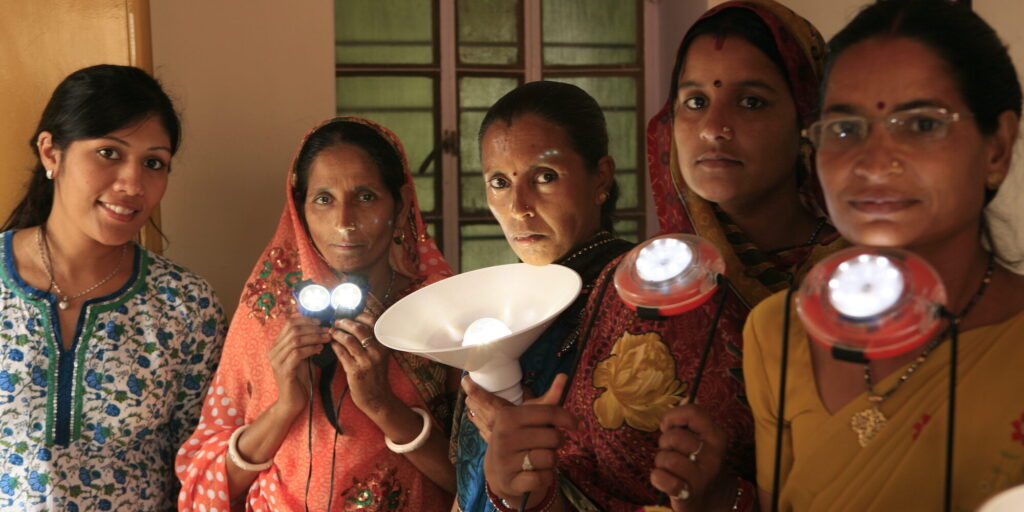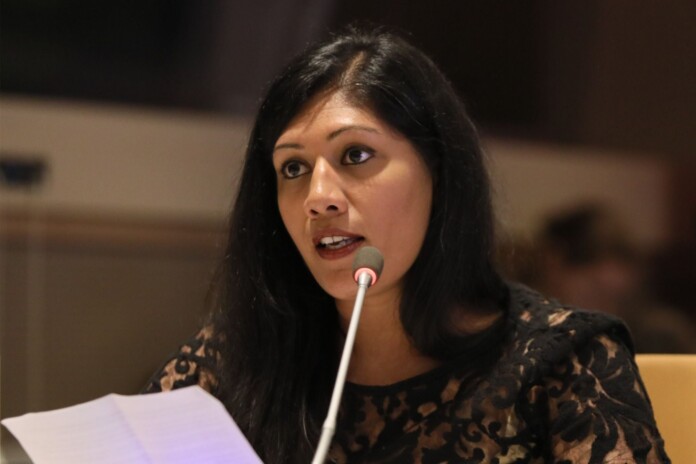Ajaita Shah was one of the four inspiring leaders who discussed their work and how their passions led to great change by assisting communities, at the 10th Indiaspora Global Conference in Gurugram, in August 2022. SustainabiltyNext will feature rest of the speakers in subsequent issues. Here’s the first:
Ajaita Shah, 38, has spent half her life, and her entire professional career, working in rural India. She moved to India right after college from New York. She thought that she would come for ten months like a lot of the kids do, work for an NGO for ten months, get a good thing to put on a resume, and then go back to America and become a lawyer. But for her, ten months became 18 years.

Edited Excerpts
Rural India Big Business Opportunity
I worked in the microfinance sector when I first started, which was at the peak time of asking the question: how we might serve women better through financial services. And people thought it was going to be impossible to do because they said 7000 villages, 800 million people, unbankable, don’t know them, can’t reach them. But actually, the reality was this was completely wrong.
It was an opportunity to really understand the crux of people and who they are and where they come from. If you started looking at a lens of customer centricity versus poor beneficiary. That is really what changed my life – I worked in 5000 villages, 7 states of the country, thousands of slums, really trying to understand who Bharat India is and who their people are.
It’s no trade secret that rural India has become the biggest social, economic and environmental market opportunity in the world. I’d like to reflect together on the most important learnings that came from these opportunities. So, when you look at rural India you see challenges, right.
Clearly people, when they are living in remote villages and they’re not necessarily being able to deliver quality services like good healthcare, cheap financial services, better quality appliances, clean water, electrification. You really are denying their ability to have an easier life because the challenges that they are facing are preventing them from climbing any sort of economic ladder. But the fact is that if you can look at this as a challenge, sure. Or you can look at this as a big market opportunity: how might we better serve rural customers that are frankly the largest customer base in the country.
Women Collectives
And when we start thinking about the work that our communities have done, whether it’s the NGOs or the governments, they’ve done a pretty amazing job socially empowering an ecosystem, really looking at creating self-help groups or women collectives that have over a hundred million women in a group that are linked to bank linkages. So, a lot of that has created a shift also in India, where you’re realizing that rural families are actually quite aspirational, and they’re believing that they deserve access to better services, better quality and they want it in a way that’s actually very homogenous and convenient.

Common Trends that Unite Rural India
There’s another thing that I learned very quickly, which was that…you know, people that I meet in America tell me, ‘well rural India’s really hard because there’s different cultures, different languages so there’s no homogenous zone of India.’
I disagree completely after spending this much time. The reality is there are common threads. The common threads that unite rural communities is everybody has aspiration, everyone wants to be economically empowered, everybody wants a better life for their children, and frankly speaking they want it quickly and they are passionate and aspiring to do it now. That is an amazing common thread that we need to start understanding in terms of linking verses saying that it’s all too tough, it’s too difficult, it’s too far away.
When I started at Frontier markets, our mantra was very simple – How do we create an easier life for rural families, and how do we treat them with customer centricity. So instead of pushing solutions at them, how do we learn from them and then co-create and build trust. And most importantly, how do we do that through the lens of women. One thing we’ve learned is that when you invest in women, you build trust in a very different way because women are the critical players that connect communities. So, the age-old understanding that we know is that ‘the customer is King’, which of course resonates with us in terms of what we do, but we also learned that ‘Rural women are Queens’.
And indeed, in the last decade, my greatest lesson and business strategy has been recognizing the evolving power of rural women. They are natural influencers, natural observers, born connectors and enablers. And what’s more important is that they are highly motivated to be drivers of change – when women earn money, 90% of their income goes back into their families, goes back into their communities.
And that’s really why, when people ask, ‘what does it mean to invest in women, why should we be giving them financial opportunities, or income generating opportunities?’ The reality is, if you don’t there isn’t going to be an opportunity to create drivers of change and impact in society. It’s just a fact.
So, when we started partnering with rural women directly, we started looking at how she can be helping us in terms of addressing challenges directly, because she is able to tell you, not just her problems, she’s able to tell you everybody’s problems. She literally knows everything that’s going on in that village. And when you start listening to her properly, you can start building with her and find different solutions because she doesn’t just tell you that, oh, we don’t have water. She tells you why we don’t have water, what the problem with the quality of water is, who has access, who doesn’t have access. When you start co-creating solutions with her, everything changes.
And i think, when we started looking at this feminist lens, saying, don’t assume she doesn’t know anything, but please understand that she’s the voice. Everything can change in a really exciting way, and you can start thinking about how to solve problems for 800 million people. How do you design better healthcare solutions, how do you find better financial services, how do you start understanding that 51% of farmers are women and you need to actually create better gender inclusive products to serve rural women farmers.
Why Women Should Get Kisan Credit Card
And my fun fact, when I did this exercise with our rural women was that…How many of you guys know about the kisan credit card? It was like the biggest thing that was created in India and the shocking reality is that even though 51% of farmers are women, not a single woman has a kisan credit card. And do you know why? Because the criteria is that you have to own land. Who owns land in agri families? It’s the men. Who does hisaab of books in farming? It’s the women.
So who’s more financially savvy to get a kisan credit card? So you know when you start thinking about the logic of what we are missing because we are not using a feminist lens because we are making assumptions that she’s a bichari (hopeless) and that she needs hand holding and that there are limitations to her, you’re denying your ability to actually work on solving problems in a smart way.
So, for me, it was very easy – instead, let’s also design for these women. A lot of times people tell me like, ‘well, you know the problem with creating women entrepreneurs is that she can’t travel, she can’t work eight hours a day, she’s not smart enough, she’s not educated, she doesn’t have phones…’ Sure, but then turn it into an opportunity, understand that she’s extremely busy and it’s because she’s a farmer, she’s a self-help group leader, she’s a mother, and she’s actually a multitasker.
So how do you design a program where she doesn’t have to work eight hours a day? And the reason why she doesn’t travel is not because she can’t, it’s because she doesn’t have time. And the fact of the matter is that she is the social influencer. So instead of making her go to ten villages, let her work in the one village that she can do the most with because she knows the most. She’s not educated, she’s entrepreneurial. She really understands how to make the most of what she has. And if you start designing programs that way, which is what we’ve done, everything changes.
Today we have 20,000 women entrepreneurs that have helped over a million families get access to health services, digital payments, financial services, agri-solutions, climate resilience – it’s the largest platform in the country with a gender voice for a reason.
And these women are earning real money, right, they’re earning 5,000 rupees a month, they’re investing back into their families, they’re making their daughters go to private education schools. In Rajasthan where we work, they’ve helped child marriages stop. And this is where you start understanding the power of impact.
It’s time to scale
If you start thinking about the role that women can play in terms of data, if you start thinking about the role that women are in this ecosystem, we’ve said that it’s time to now scale. So there are a hundred million women today in SHG groups in the country and they all are looking to make a difference in their lives.
So on my birthday yesterday (August 10th), I launched the one thing that I want to leave with this community, which is how might we, together, design an opportunity in which a million women impact a hundred million women in an initiative where were talking about a stakeholder that comes together called “She Leads Bharat.” The goal is how NGOs, the government, donors, market-linkage solution players, technology and data come together to finally look at a feminist approach to really help these women become rockstars at scale.










